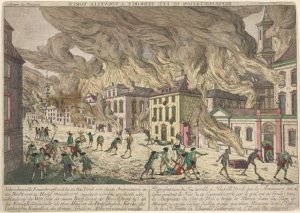The fire of 1776 commenced in a small wooden house on the wharf, near the Whitehall Slip. It was then occupied by a number of men and women of bad character. The fire began late at night. There being but a very few inhabitants in the city, in a short time it raged tremendously.
It burned all the houses on the East side of Whitehall Slip, and the West side of Broad Street, to Beaver Street. A providential and happy circumstance occurred at this time. The wind was then south-westerly. About two o'clock that morning, the wind veered to the south-east. This carried the flames of the fire to the north-westward, and burned both sides of Beaver street to the east side of Broadway, then crossed Broadway to Beaver lane, and burning all the houses on both sides of Broadway, with some few houses in New street, to Rector street, and to John Harrison, Esq.'s three-story brick house, which house stopped the fire on the east side of Broadway.
From thence it continued burning all the houses in Lumber street, and those in the rear of the houses on the west side of Broadway to St. Paul's Church; then continued burning the houses on both sides of Partition street, and all the houses in the rear (again) of the west side of Broadway to the North River. The fire did not stop until it got into Mortkile street, now Barclay street. The College yard, and the vacant ground in the rear of the same, put an end to this awful and tremendous fire.
Trinity Church being burned, was occasioned by the flakes of fire that fell on the south side of the roof. The southerly wind fanned those flakes of fire in a short time to an amazing blaze, and it soon became out of human power to extinguish the same, the roof of this noble edifice being so steep that no person could go on it.
St. Paul's Church was in the like perilous situation. The roof being flat, with a balustrade on the eaves, a number of the citizens went on the same, and extinguished the flakes of fire as they fell on the roof. Thus, happily, was this beautiful church saved from the destruction of this dreadful fire, which threatened the ruin thereof and that of the whole city.
The Lutheran Church being contiguous to houses adjoining the same fire, it was impossible to save it from destruction. This fire was so furious and violently hot, that no person could go near it, and there were no fire-engines to be had at that time in the city.
The number of houses that were burned and destroyed in this city at that awful conflagration were thus, viz.:-
From Mortkile street to Cortlandt street................167
From Cortlandt street to Beaver street.......... ......175
From Beaver street to the East River...................151
___
Total..............................493
There being very few inhabitants in the city at the time, and many of those were afraid to venture at night in the streets, for fear of being taken up as suspicious persons.
An instance, to my knowledge, occurred. A Mr. White, a decent citizen and house carpenter, rather too violent a loyalist, and latterly had addicted himself to liquor, was, on the night of the fire, hanged on a tavern sign-post, at the corner of Cherry and Roosevelt street. Several of the citizens were sent to the Provost Guard for examination; and some of them remained there two and three days, until they could give satisfactory evidence of their royalty.
Mr. Hugh Gain, in his Universal Register for the year 1787, page 119, says__"New York is about a mile and a half in length, and half a mile broad, containing, before the fires on the 21st of September, 1776, and 3d of August, 1778, about 4,200 houses, and 30,000 inhabitants."
Source of Information: From My collection of books: Manual of the Corporation of the City of New York for 1852 by D.T. Valentine; George P. Putnam, 10 Park Place.
To contact: miriam@thehistorybox.com
.
Thursday, February 18, 2010
Subscribe to:
Post Comments (Atom)


No comments:
Post a Comment